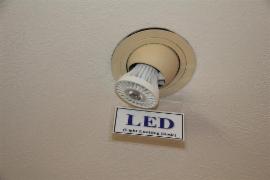LED = Light Emitting Diode (saves double of a CFL)
LED Light examples around the house:
Below Microave oven: LED Strip glued with double sided foam tape from Ledtronics.com:

LED Flood in ceiling canister: 18 watt (90 watt equivalant) EcoSmart from HomeDepot. The 90 watt equivalents are so bright, I used them for Outside flood lights. They light up the yard much better than my old 150 watt incondescents.
(EcoSmart from HomeDepot, comes in warm and cool daylight spectrum)

Book Shelf spot from Home Depot for tiny fixtures:

HISTORY: The LED does the exact opposite of PV solar panel. The LED takes in DC electricty and produces light! A "diode" (last letter of LED) allows electricty to move in only one direction and stops electricity if it tries to move in the reverse direction. Add a little impurities in the mix and it glows! A single LED only needs about 2 to 3 volts to glow with light. LEDs use so little electricity (1/8th of an incondescent bulb) that they work with just a battery making them great for RVs and flash lights. By comparison CFL (Compact Florescent Lights) use more at 1/4th of an incondescent bulb), so LEDs ARE MUCH MORE EFFICIENT THAN "OLD" CFL! LED lights keep getting cheaper, just like CFLs got cheaper over the years.
< Early years of LED lights: 2003 to 2009 "OLD" LED spot light technology in a canister fixture. The new 2010 (and later) lights need only one or a few silicone elements
HISTORY: In 1962 LEDs were introduced in the USA from Russia. LEDs were discovered by mistake due to unwanted dust getting into the manufacturing of diodes. By 1970 the first LED watches were sold at about $300. The price came down quickly as calculators became main stream and "slide bars" went out of business in 1972-3
November, 2008: Costco and Sam's Club were the first to introduce main stream pricing of LED bulbs and Spot lights. A 5 watt (90 LED) spot = $14 and a 3 watt (60 LED) spot = $8
FAN LIGHT: I replace the "old" CFL lights in the kitchen fan light with LED floods. Since LEDs use so little electricty, I installed "y" sockets from Home Depot and doubled up the number of spots from 4 to 8 for a total of only 8x 5watts = 40 watts. Compare 40 watts to the original 4 x 60 watt bulbs adding up to a huge 60 X 4 = 240 watts!
This 24" underCabinet strip lighting = $60 from LEDTRONICS.com. It easily mounts with double sided foam tape. It comes in 3 white colors and narrow or wide beam. The Three colors are: 1) Full Spectrum day light, 2) bright white, and 3) warm white. For the kitchen don't buy warm white or your fruits and vegetables will not have good color.
In the below picture, note that I glued the LED strip lighing to the underside of the Microwave oven. The Stove is now lite up very well compared to the old yellow light that was built in the Microwave.
Below: These LED spots are on top of the cabinets and bounce light off the ceiling to fill the kitchen with light.
Above: Orange Tie wraps with molded screw holes and the sockets (clamped to extension cords) came from Home Depot. The 120 volt electrical outlet for the Under cabinet lighting is in the cabinet above the Microwave. The strip LEDs are powered by a 12 volt DC transformer plugged into the same outlet in the same cabinet. The wall switch turns the cabinet lights on/off.
BELOW: TRACT LIGHTING IS GREAT FOR LED lights. This bedroom used to have three x 4 foot florescent lights. Now, 15 tract LED bulbs, 3 watts each, produce about the same amount of light for a total of only 45 watts. (about the same as ONE four foot T12 bulb). The color rendition on pictures and bedding cloth is much much better.